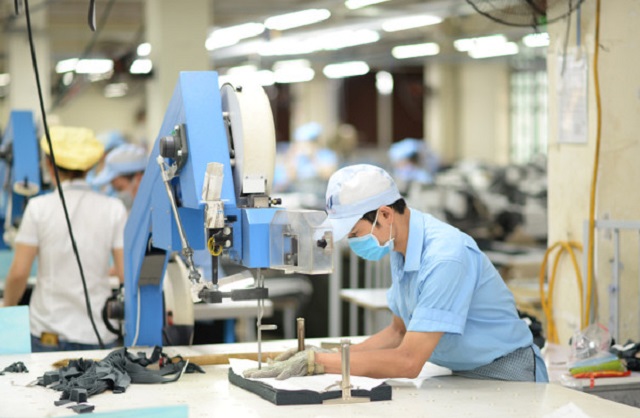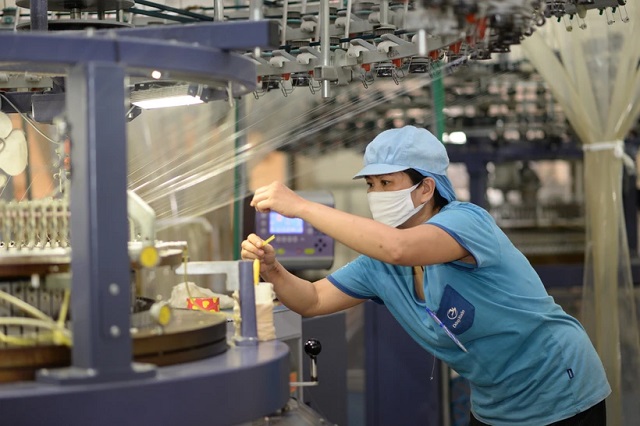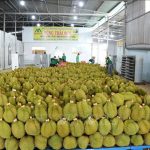
|
Vietnamese textile and garment enterprises going green to meet high market standards. (Photo: PV/Vietnam+)
|
Fierce competition and economic tensions between powerhouse nations have significantly impacted the export of various Vietnamese products.
Amid global economic fluctuations, textile and garment businesses are enhancing their market presence, connecting with partners to expedite orders, and focusing on developing new markets to mitigate future risks.
Seizing Opportunities Amid Challenges
In 2024, Vietnam’s textile and garment exports reached approximately 43.5 billion USD, ranking the country second globally, just behind China. However, the rise in protectionist trade policies from various nations could impact Vietnam’s textile industry.
Mr. Le Tien Truong, Chairman of the Vietnam Textile and Apparel Association (Vitas), acknowledged the potential impact of the US’s temporary tax policy on Vietnam’s textile exports. Despite low US inventory levels suggesting strong orders in Q3 2025, Q4 2025 orders may decline due to reduced consumer demand in that market.
“Despite market fluctuations, current tariff negotiation policies are implemented per product category, presenting opportunities for Vietnam’s textile and garment industry,” said Mr. Le Tien Truong.

|
Textile and garment enterprises meeting market standards to boost exports. (Photo: Duc Duy/Vietnam+)
|
Statistics show that the US market accounts for about 35-40% of Vietnam’s textile and garment exports. However, to mitigate risks, many businesses are focusing on developing potential customers.
Ms. Nguyen Hong Lien, CEO of Hue Textile and Garment JSC, shared that production and delivery plans have been subject to fluctuations since the US’s tax declaration. Initially, some customers paused orders, then requested expedited delivery when a 10% tax was imposed for 90 days. However, current calculations show that most April, May, and June orders are on track per the initial plan.
Regarding Q3 and Q4 orders, Hue Textile and Garment JSC has secured orders for July. However, increased competition is expected due to more stringent evaluation requirements, particularly in social responsibility, security, and quality management systems.
“Hue Textile and Garment JSC continues to receive FOB orders (providing raw materials and completing products) in Q3. For fabrics imported from China, suppliers have agreed to share material costs, reducing them by 25-27%, to retain customers and provide support during challenging times if taxes are imposed. Customers anticipate that Q4 orders may decrease compared to the same period last year, depending on the segment,” said Ms. Nguyen Hong Lien.
Meanwhile, May Hung Yen JSC has received several requests from partners. For Korean customers, although the orders are not large, the company still needs to negotiate a slight price reduction, expected to be around 1%.
Ms. Pham Thi Phuong Hoa, CEO of May Hung Yen JSC, shared that the company has a continuous production plan until mid-August and is in discussions to receive additional orders. However, they predict a slight decrease in demand in the US market.
“From now until the end of July, especially in June and early July, May Hung Yen JSC’s production situation is quite tense. This is because customers require on-time delivery and do not accept schedule changes as in previous years. Delayed delivery entails various risks regarding transportation and timing, so our entire production system is currently highly focused on completing orders,” added the representative of May Hung Yen JSC.
Capitalizing on Competitive Advantages
According to Vinatex’s report, Vietnam’s textile and garment exports in April 2025 reached 3.64 billion USD, a 15% increase over the same period last year. In the first four months of 2025, exports of these products reached 13.9 billion USD, up 11% year-on-year.
Apart from the US market, key export markets such as Japan and Europe have also shown growth, prompting businesses to negotiate with partners to boost exports to these markets.
Mr. Nguyen Hung Quy, CEO of Vinatex Southern Corporation, shared that as of now, Vinatex Southern Corporation has received sufficient orders to last until the end of August. In response to developments related to export tariffs to the US, Vinatex Southern Corporation has proactively developed other markets such as Europe and the UK. The proportion of orders from these markets in the last months of the year has significantly increased compared to the beginning of the year.
“Regarding market assessment, we believe that if the negotiated countervailing tax increases by 15-20%, it will still be acceptable for the Vietnamese market. We also propose the need for transparency in the certification of origin,” said the representative of Vinatex Southern Corporation.

|
Many enterprises have focused on high-value-added brands to maintain their market share. (Photo: Duc Duy/Vietnam+)
|
Ms. Nguyen Thi Phuong Thao, Director of May10 Corporation, shared that May10 currently has orders until the end of July, with some types of jackets extending until the end of August and other products until the end of the year. For orders at the beginning of July, customers requested early delivery, leading to tremendous production pressure. May10 has had to organize flexible production and overtime to meet these demands.
“Currently, May10 is proactively seeking and expanding its raw material supply sources by connecting with Vinatex members and some enterprises in India and Taiwan,” said the representative of May10.
Meanwhile, Mr. Pham Tien Lam, CEO of Duc Giang Corporation, shared that, along with taking advantage of working hours to export goods within the 90-day period before the US imposes taxes, the company is also targeting potential markets such as Australia and Japan. Positive signals have recently emerged from the Chinese market.
“In the US market, the textile and garment industry needs to find ways to prevent customers from withdrawing or reducing orders and maintain stable production without too much pressure, especially price pressure. Therefore, the right approach is to focus on customers and high-value-added brands, which aligns with Duc Giang’s capabilities and strengths. The company plans to maintain stability until the end of July and is currently receiving additional orders for August and September,” said Mr. Pham Tien Lam./.
Duc Duy
– 08:49 04/06/2025
A Sunny Outlook for Vietnam’s Fruit and Vegetable Exports
According to the Ministry of Agriculture and Rural Development, fruit and vegetable exports reached $3.4 billion in the first half of 2024, a significant 28% increase compared to the same period last year. Vietnam’s fruit and vegetable exports are forecasted to remain on this positive trajectory, with the agriculture industry working closely with local authorities to establish specialized farming regions linked to value chains, building on this momentum to drive further growth.

















